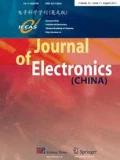Abstract
High Resolution Wide Swath (HRWS) Synthetic Aperture Radar (SAR) often suffers from low Signal-to-Noise Ratio (SNR) due to small transmitting antenna, especially in phased array antenna systems. Digital Beam Forming (DBF) based on Single Input and Multiple Output (SIMO) achieves receiving array gain at the cost of increasing data rate. This letter proposes a new HRWS SAR method, which employs intra-pulse null steering to get receiving gain in elevation and decrease the data rate, and Multiple Input and Multiple Output (MIMO) using Space-Time Block Coding (STBC) in azimuth to get transmitting gain and receiving array gain simultaneously. The feasibility is verified by deduction and simulations.
Similar content being viewed by others
References
Marwan Younis and Christian Fischer. Digital beam-forming in SAR systems. IEEE Trans. on Geoscience and Remote Sensing, 41(2003)7, 1735–1739.
M. Suess, B. Grafmueller, and R. Zahn. A novel high resolution, wide swath SAR system. International Geoscience and Remote Sensing Symposium, Sydney, Australia, July 9–13, 2001, vol.3, 1013–1015.
Christian Fischer, Christoph Schaefer, and Christoph Heer. Digital beamforming antenna for synthetic aperture radar. The Second European Conference on Antennas and Propagation, Edinburgh, UK, Nov. 11–16, 2007, 1–5.
Gerhard Krieger, Nicolas Gebert, and Alberto Moreira. Multidimensional waveform encoding, a new digital beamforming technique for synthetic aperture radar remote sensing. IEEE Trans. on Geoscience and Remote Sensing, 46(2008)1, 31–46.
Hamid Jafarkhani. Space-time Coding Theory and Practice. New York, Cambridge University Press, 2005, 55–59.
Mohinder, Jankiraman. Space-time Codes and MIMO Systems. London, Artech House, 2004, 75–84.
Jung-Hyo Kim and Alicja Ossowska. Investigation of MIMO SAR for interferometry. Proceedings of the 4th European Radar Conference, Münich, Oct. 10–12, 2007, 51–54.
Li Shiqiang and Yang Ruliang. Error analysis of displaced phase centers multiple azimuth beam synthetic aperture radar. Acta Electronica Sinica, 32(2004)9, 1436–1440 (in Chinese). 李世强, 杨汝良. 天线相位中心偏移方位多波束合成孔径雷达的误差分析. 电子学报, 32(2004)9, 1436–1440.
G. D. Callaghan and I. D. Longstaff. Wide-swath space-borne SAR using a quad-element array. IEE Proc-Radar, Sonar and Navigation, 146(1999)3, 159–165.
Author information
Authors and Affiliations
Corresponding author
Additional information
Communication author: Chen Longyong, born in 1979, male, Ph.D.
About this article
Cite this article
Chen, L., Liang, X. & Ding, C. A High Resolution Wide Swath SAR method based on intra-pulse null steering and MIMO. J. Electron.(China) 25, 813–816 (2008). https://doi.org/10.1007/s11767-008-0053-4
Received:
Revised:
Published:
Issue Date:
DOI: https://doi.org/10.1007/s11767-008-0053-4
Key words
- High Resolution Wide Swath (HRWS) Synthetic Aperture Radar (SAR)
- Intra-pulse null steering
- Multiple Input and Multiple Output (MIMO)
- Signal-to-Noise Ratio (SNR)
- Space-Time Block Coding (STBC)




